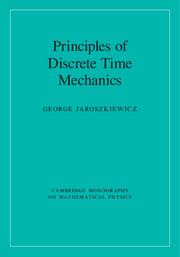Book contents
- Frontmatter
- Contents
- Preface
- Part I Discrete time concepts
- Part II Classical discrete time mechanics
- Part III Discrete time quantum mechanics
- Part IV Discrete time classical field theory
- Part V Discrete time quantum field theory
- 26 Discrete time quantum field theory
- 27 Interacting discrete time scalar fields
- Part VI Further developments
- Appendix A Coherent states
- Appendix B The time-dependent oscillator
- Appendix C Quaternions
- Appendix D Quantum registers
- References
- Index
27 - Interacting discrete time scalar fields
from Part V - Discrete time quantum field theory
Published online by Cambridge University Press: 05 May 2014
- Frontmatter
- Contents
- Preface
- Part I Discrete time concepts
- Part II Classical discrete time mechanics
- Part III Discrete time quantum mechanics
- Part IV Discrete time classical field theory
- Part V Discrete time quantum field theory
- 26 Discrete time quantum field theory
- 27 Interacting discrete time scalar fields
- Part VI Further developments
- Appendix A Coherent states
- Appendix B The time-dependent oscillator
- Appendix C Quaternions
- Appendix D Quantum registers
- References
- Index
Summary
In this chapter we explore the discrete time (DT) quantum field theory (QFT) of a system under observation described via a self-interacting neutral scalar field, as an illustration of the sort of techniques and results we encounter in such a theory.
We have commented several times in other chapters on the importance of recognizing the architecture of an experiment or theory describing that experiment. The same is true here. Even in continuous time (CT) QFT, it was found necessary to modify the architecture used in scattering calculations. It was found to be no longer sufficient to keep to a single Hilbert-space architecture as in Figure 5.1(a), so the architecture had to be extended to incorporate the observers in some way. The usual abbreviation for the enhancement of this architecture is LSZ, after Lehmann, Symanzik and Zimmermann, who added an ‘in’ free-particle Hilbert space to model the processes of state preparation and an ‘out’ free-particle Hilbert space to model the process of state detection (Lehmann et al., 1955).
An important factor in the LSZ formalism is the recognition that the ultimate objectives in QFT are scattering amplitudes, rather than solutions to operator equations of motion. The former are objects from which physical quantities can be calculated, whilst the latter are ill-defined at best and would have to be processed further anyway by the taking of matrix elements in order to be of any use.
Information
- Type
- Chapter
- Information
- Principles of Discrete Time Mechanics , pp. 306 - 320Publisher: Cambridge University PressPrint publication year: 2014
